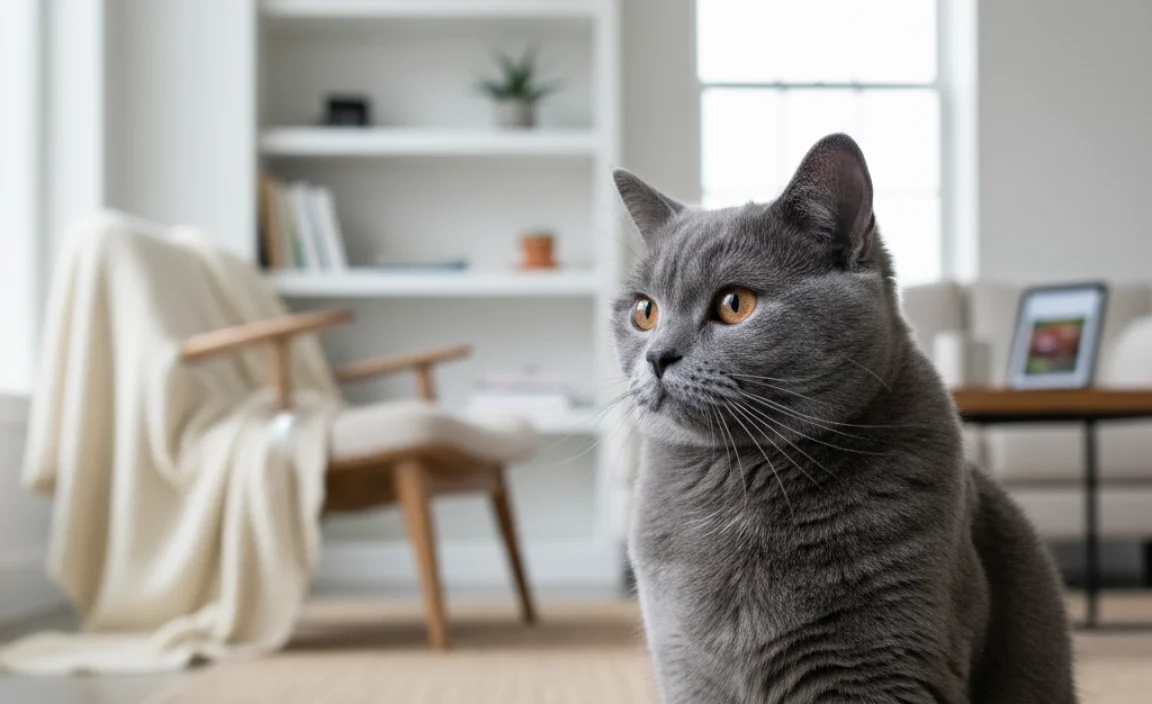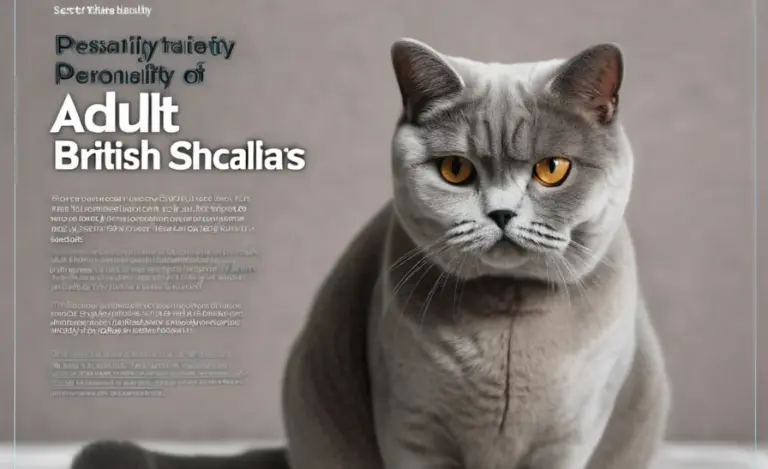Are British Shorthairs adaptable to new homes? Find Out!
Quick Summary: Yes, British Shorthairs are generally adaptable to new homes, but they appreciate a calm and gradual introduction. Their laid-back nature helps, but providing a safe space, maintaining routine, and understanding their individual personality are key to a smooth transition. Patience and consistency are your best friends!
Bringing a new cat home is exciting! But you might be wondering if your British Shorthair will settle in okay. It’s a common concern for new owners. Will they be scared? Will they hide? The good news is that British Shorthairs are known for their easy-going personalities. With a little planning and understanding, you can help your new furry friend feel right at home. Let’s explore how to make the transition as smooth as possible.
Understanding the British Shorthair Temperament

Before diving into the how-to, it’s helpful to understand the typical British Shorthair temperament. These cats are known for being:
- Calm and relaxed: They’re not usually high-strung or easily agitated.
- Independent: They enjoy their own company and don’t demand constant attention.
- Affectionate (on their terms): They’ll show affection when they feel like it, often preferring to be near you rather than on your lap.
- Adaptable: They can adjust to new environments, but they need time and patience.
However, remember that every cat is an individual. Some British Shorthairs are more outgoing than others. Pay attention to your cat’s personality and adjust your approach accordingly.
Step-by-Step Guide to Helping Your British Shorthair Adapt

Here’s a step-by-step guide to help your British Shorthair adjust to their new home:
Step 1: Prepare a Safe Space
Before you even bring your cat home, set up a safe and comfortable space for them. This should be a quiet room or area where they can retreat and feel secure. Include these essentials:
- Cat bed: A cozy bed where they can sleep and relax.
- Food and water bowls: Place them in an easily accessible location, away from the litter box.
- Litter box: Choose a litter box that’s appropriate for your cat’s size and age.
- Scratching post: This will help them stretch their muscles and sharpen their claws.
- Toys: Provide a variety of toys to keep them entertained.
Make sure this space is free from loud noises and heavy foot traffic. This will help your cat feel safe and secure as they adjust to their new surroundings.
Step 2: The Arrival
When you bring your British Shorthair home, gently place the carrier in the prepared safe space. Open the door and let your cat come out on their own terms. Don’t force them!
Some cats will immediately explore, while others will hide. Both reactions are normal. If your cat hides, don’t try to coax them out. Just let them be. They’ll come out when they feel ready.
Step 3: Gradual Exploration
Once your cat starts to explore the safe space, you can gradually introduce them to other parts of the house. Do this slowly and one room at a time. Leave the door to the safe space open so they can always return if they feel overwhelmed.
Supervise their explorations and make sure they don’t get into anything dangerous. If they seem scared or anxious, gently guide them back to the safe space.
Step 4: Maintaining Routine
Cats are creatures of habit, so maintaining a consistent routine is crucial for helping them adjust to a new home. Feed them at the same time each day, clean their litter box regularly, and set aside time for play and interaction.
A predictable routine will help your cat feel secure and in control, which can reduce anxiety and stress.
Step 5: Building Trust and Bonding
Building trust and bonding with your British Shorthair takes time and patience. Here are some tips:
- Speak in a soft, gentle voice: Avoid loud or sudden noises.
- Offer treats: Use treats to reward positive behavior and create positive associations.
- Play with them: Engage in interactive play sessions using toys like wands or laser pointers.
- Pet them gently: Most British Shorthairs enjoy being petted on their head, cheeks, and back. Pay attention to their body language and stop if they seem uncomfortable.
- Spend time near them: Even if you’re just reading a book or watching TV, your presence will help them feel more comfortable.
Avoid forcing interaction or picking them up if they don’t want to be held. Let them come to you on their own terms.
Step 6: Introducing Other Pets
If you have other pets, introduce them to your British Shorthair gradually and carefully. Keep them separated at first, allowing them to smell each other under the door.
Supervise their first interactions and be prepared to separate them if they start to fight. Reward positive interactions with treats and praise.
It can take weeks or even months for cats and dogs to fully adjust to each other. Be patient and don’t force the process.
Step 7: Monitoring Their Health
Keep a close eye on your British Shorthair’s health during the adjustment period. Stress can weaken their immune system and make them more susceptible to illness.
Watch out for these signs of stress or illness:
- Loss of appetite
- Lethargy
- Hiding
- Changes in litter box habits
- Excessive grooming
- Vomiting or diarrhea
If you notice any of these signs, consult your veterinarian.
Creating the Perfect Environment

Beyond the initial steps, there are several environmental factors that can help your British Shorthair thrive in their new home:
Vertical Space
Cats love to climb and explore, so provide plenty of vertical space. This can include cat trees, shelves, or window perches. Vertical space gives them a sense of security and allows them to observe their surroundings from a high vantage point.
Scratching Opportunities
Scratching is a natural behavior for cats, so provide plenty of scratching posts or pads. Different cats have different preferences, so offer a variety of materials, such as cardboard, sisal, or carpet.
Safe Hiding Places
Even confident cats need a safe place to retreat when they feel overwhelmed or scared. This can be a covered cat bed, a cardboard box, or a quiet corner under a piece of furniture.
Enrichment and Play
Keep your British Shorthair entertained and stimulated with a variety of toys. Rotate the toys regularly to keep them interested. Interactive play sessions are also important for bonding and preventing boredom.
Consider puzzle feeders to make mealtime more engaging and challenging. These feeders require your cat to work for their food, which can help prevent overeating and boredom.
Troubleshooting Common Issues

Even with the best preparation, some British Shorthairs may experience challenges adapting to a new home. Here are some common issues and how to address them:
Hiding
It’s normal for cats to hide when they first arrive in a new home. Don’t try to force them out. Just provide them with a safe and comfortable hiding place and let them come out on their own terms. Offer food and water near their hiding place to encourage them to emerge.
Inappropriate Elimination
If your British Shorthair is eliminating outside the litter box, it could be a sign of stress or a medical problem. Rule out any medical issues with a vet visit. Make sure the litter box is clean and easily accessible. Try different types of litter to see if your cat has a preference.
You may also need to add more litter boxes, especially in a multi-cat household. The general rule is one litter box per cat, plus one extra.
Scratching Furniture
If your cat is scratching furniture, it means they don’t have enough appropriate scratching surfaces. Provide plenty of scratching posts and pads in different locations. You can also try using catnip or pheromone sprays to attract them to the scratching posts.
Make the furniture less appealing by covering it with blankets or using double-sided tape.
Aggression
Aggression towards people or other pets is a serious issue that requires professional help. Consult with a veterinarian or a certified cat behaviorist to identify the underlying cause and develop a treatment plan.
Never punish your cat for aggressive behavior. This will only make the problem worse.
Understanding Cat Communication

Learning to understand your British Shorthair’s body language and vocalizations can help you better understand their needs and emotions. Here are some key signs to watch for:
| Behavior | Meaning |
|---|---|
| Purring | Usually indicates contentment, but can also be a sign of stress or pain. |
| Hissing | A warning sign indicating fear or aggression. |
| Growling | A more serious warning sign indicating a higher level of aggression. |
| Rubbing against you | Marking you with their scent and showing affection. |
| Kneading | A sign of contentment, often associated with nursing as a kitten. |
| Tail twitching | Can indicate excitement, irritation, or focus. |
| Ears flattened | A sign of fear or aggression. |
| Slow blinking | A sign of trust and affection. |
Pay attention to the context of the behavior and consider other body language cues to get a complete picture of your cat’s mood.
The Importance of Patience
The most important thing to remember when helping your British Shorthair adjust to a new home is to be patient. It can take weeks or even months for some cats to fully settle in. Don’t get discouraged if your cat doesn’t immediately adjust. Just keep providing them with a safe, comfortable, and loving environment, and they will eventually come around.
Seeking Professional Help
If you’re struggling to help your British Shorthair adjust to their new home, don’t hesitate to seek professional help. A veterinarian or a certified cat behaviorist can provide valuable guidance and support. They can help you identify any underlying medical or behavioral issues and develop a tailored plan to address them.
British Shorthair-Specific Considerations
While the general advice applies to most cats, here are some considerations specific to British Shorthairs:
- They appreciate a calm environment: British Shorthairs are not usually fans of loud noises or chaotic households.
- They are prone to weight gain: Monitor their food intake and provide plenty of opportunities for exercise.
- They have a dense coat: Regular grooming is essential to prevent matting and hairballs.
Understanding these breed-specific traits can help you provide the best possible care for your British Shorthair.
Resources for New Cat Owners
Here are some helpful resources for new cat owners:
- RSPCA – Cats: Comprehensive information on cat care, behavior, and health.
- The International Cat Association (TICA): Breed information, cat shows, and responsible breeding.
- Cornell Feline Health Center: Reliable information on feline health and disease.
- Purina – British Shorthair: Breed-specific information and care tips.
FAQ: Adapting British Shorthairs to New Homes
Are British Shorthairs good for first-time owners?
Yes, generally! British Shorthairs are known for their calm and independent nature, making them a good fit for first-time owners who can provide a stable and loving environment.
How long does it take for a British Shorthair to adjust to a new home?
It varies! Some adjust in a few days, others take weeks or even months. Patience is key. Provide a safe space and consistent routine, and they’ll come around.
My British Shorthair is hiding all the time. What should I do?
Don’t force them out. Make sure their safe space is comfortable, with food, water, and a litter box nearby. Let them emerge when they feel ready. Offer gentle encouragement with a soft voice and treats.
How can I tell if my British Shorthair is stressed?
Signs of stress include hiding, loss of appetite, changes in litter box habits, excessive grooming, and aggression. If you notice these, consult your vet.
Can I leave my British Shorthair alone all day?
British Shorthairs are independent, but they still need companionship. Short periods alone are fine, but provide plenty of enrichment (toys, scratching posts) and interaction when you’re home. Consider a pet sitter if you’re gone for extended periods.
Do British Shorthairs get lonely?
Yes, they can. While they are independent, they still crave affection and interaction. Make sure to provide them with plenty of attention and playtime to prevent loneliness.
How do I introduce my British Shorthair to my dog?
Introduce them slowly and carefully. Keep them separated at first, allowing them to smell each other under the door. Supervise their first interactions and be prepared to separate them if they fight. Reward positive interactions with treats and praise.
Conclusion
Bringing a British Shorthair into your home is a rewarding experience. While they are generally adaptable cats, a smooth transition requires understanding, patience, and a little planning. By creating a safe and comfortable environment, maintaining a consistent routine, and building trust through gentle interaction, you can help your new furry friend feel right at home. Remember to monitor their health, seek professional help when needed, and most importantly, be patient. With your love and care, your British Shorthair will thrive and become a cherished member of your family for years to come.




